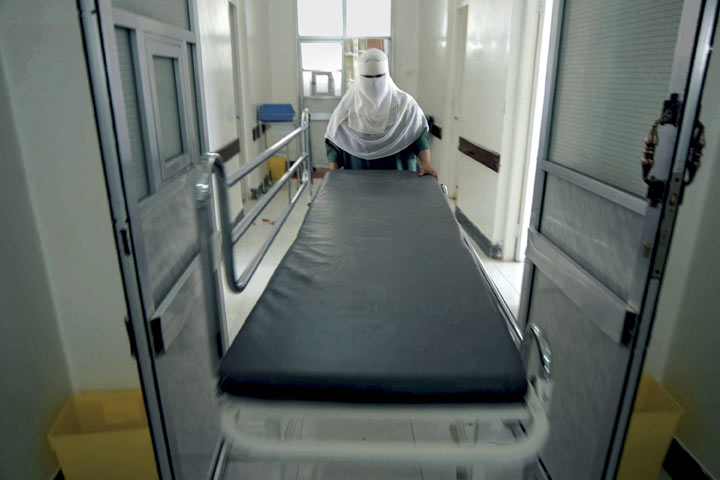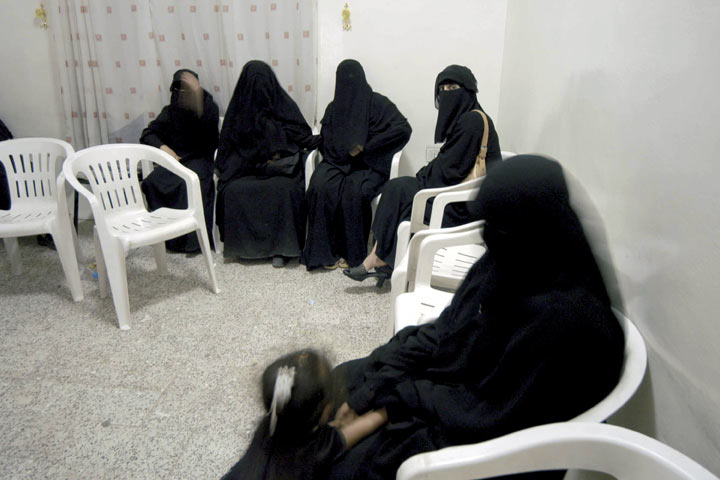IN A COUNTRY WHERE MODERN MEDICINE IS STILL CONSIDERED A CONSPIRATORIAL THREAT TO TRADITION, A QUIETLY HEROIC FEMALE DOCTOR RALLIES FOR WOMEN’S HEALTH—SAVING BABIES AND THEIR MOTHERS ONE CONVERT AT A TIME.
By Ann Marlowe
Photos by Newsha Tavakolian
The calm and cleanliness of Women’s and Children’s Hospital in Sana’a, Yemen, is a surprise when you walk in from the crowded, littered streets. In a country with such high rates of maternal and infant mortality, this might easily be a dreadful place. But a cheerful atmosphere prevails in the white corridors. Maybe it’s the continuity of life inside the hospital with life outside: visiting family members sit patiently on the hallway floors that serve as waiting rooms, while shy children in frayed but elaborate Western dress-up clothes scamper about. Young boys roam the hallways and patient rooms hawking chewing gum and Saudi religious tracts.
Sana’a, Yemen, 2004
A nurse rushes a gurney down a corridor.
Women’s and Children’s Hospital, popularly known as “70th” for its location on 70th Street, is a public hospital with a clientele drawn from the poor to lower middle class of this city of 1.5 million. An extra 2,500 rials (US$13) buys a private room in the VIP ward, with two beds and a TV.
Hospital delivery is still uncommon in Yemen. The head of 70th Hospital, Dr. Jamila Al-Moayed, estimates that more than 80 percent of Yemeni babies are delivered at home with the help of a qabelah, or midwife. In the rural areas, where three-quarters of Yemenis live, that figure is closer to 100 percent. Even in Sana’a, those planning to give birth in a public hospital do so because they anticipate complications—they have a history of miscarriages, Cesarians, or difficult births. This and the lack of prenatal care helps to explain why three of the 20 women I saw who had just given birth had lost their babies. The infant death rate in ![]() Yemen is as high as 63 per 1,000 births, approximately 10 times the Western European and US rates.
Yemen is as high as 63 per 1,000 births, approximately 10 times the Western European and US rates.
Nearly all Yemeni women—patients, nurses, and doctors alike—wear the sharshaf, an elegant, close-fitting ensemble with a black polyester gown and headscarf worn over colorful and much more revealing house clothes, and the niqab, a veil. Only a few progressive-minded doctors, like Dr. Amat Al Karim Ali Hummed Al Hawari, eschew the niqab for a simple headscarf. Dr. Amat (Yemenis call doctors by their first name—it’s considered cold to use their last names) is one of the best-known gynecologists in Yemen. A pleasantly plump, short woman in her mid-40s, she is both warm and relentlessly efficient, working a 12-hour-a-day, six-day-a-week schedule in a country that dearly needs her services. Only about 3,800 doctors serve Yemen’s 20 million people.
“THEY SAY IT’S A ’WESTERN AGENDA’ WHEN YOU TALK ABOUT WOMEN. THEY SAY FAMILY PLANNING IS A WESTERN PLOT TO DESTROY MUSLIM WOMEN”
I tell Dr. Amat that I have difficulty recognizing the women without being able to see anything but their eyes, and she replies that Yeminis don’t. They grow adept at noticing small differences in expression or body language. Still, when I ask how old a particular patient is, Dr. Amat pulls back the woman’s niqab to check her laugh lines and estimates, “Maybe 40, or 45.” Many rural women don’t know exactly how old they are, since civil registration of home births is sporadic. These are also the patients most likely to be illiterate: 68 percent of Yemeni women can’t read or write.
(In 1975, the figure was 97 percent.) Why are women wearing the niqab at all in an examination room with only other women around? “Habit,” the doctor explains. Yet the sharshaf and niqab appeared relatively recently in Yemen. They were brought there by the Turks who ruled parts of the north, and spread beyond the upper class only during the last few decades, when an increasing number of Yemeni men working in Saudi Arabia had the disposable income to buy these status symbols for their wives and daughters.
Sana’a, Yemen, 2004
Dr. Amat driving to her daily rounds at the hospital and private clinic.
After morning rounds are over in the hospital, we head for the private clinic where Dr. Amat works a second job (she also has a third job, teaching at the public medical school). We pull out of the hospital gateway onto 70th Street and enter a chaotic flow of cars: aged Japanese sedans and SUVs, rickety Daihatsu jeeps that serve as communal taxis. There aren’t any other female drivers around us, and given that Shariah (Islamic law) is the foundation for Yemen’s civil code I’m surprised that Dr. Amat takes the wheel. But unlike in Saudi Arabia, Yemeni women are now allowed to travel abroad without a male family member as mahrem, or guardian, and no longer need a male relative’s permission to obtain the equivalent of a Social Security card. Since the unification of South and North Yemen in 1990, all women have had the vote, and in 2003 they made up 47 percent of voters. Further proof of Yemeni cultural flexibility (especially in contrast to their northern neighbors on the Arabian peninsula) is that despite the taboo on women showing their faces in public, every woman voter has to remove her niqab to have her photograph taken for voter registration.
“I learned to drive in Cairo,” says Dr. Amat, who received her undergraduate medical education there in the mid-1970s.
Yemen didn’t even have a medical school until the late ’70s; now the quality of medical education is so high that the public medical school at Sana’a University draws students from other Arab countries.) Women doctors were almost unheard of. Today, almost half of the 1,254 Yemeni medical students are female, and, according to Dr. Ali Al-Meeri, vice dean of student affairs at Sana’a University’s medical school, they make up most of the top 10 in each class. “The women don’t chew qat, which is associated with socializing. They study.”
Sana’a, Yemen, 2004
Dr. Amat got the idea as a little girl that she wanted to be a doctor, perhaps because her father was a hospital administrator. He encouraged his daughters’ ambitions, which was unusual for Yemeni fathers of his day.
Seven of his eight daughters (and one son) earned university degrees, and five of them received doctorates, including Dr. Amat, who studied for her Ph.D. in obstetrics and gynecology in St. Petersburg, Russia.
Specialists attached to hospitals, like Dr. Amat and her physician husband, make US$300 to US$600 a month. Dr. Amat’s afternoon work—seeing patients in the clinic—brings in 500 rials, or about US$2.70, for a consultation, and ultrasounds cost double that. Working six days a week, she might make over US$800 a month in private practice. She is the primary breadwinner in her family; her husband doesn’t like private practice and, like most Yemeni men, spends his afternoons chewing the mild stimulant qat. Maintaining a middle-class lifestyle is estimated to cost US$1,000 a month here, and Dr. Amat has three sons to educate. Her oldest, 18, wants to be a pilot. “He can go to Egypt,” Dr. Amat says, sadly, “but the cost is US$30,000 for two years.”
Dr. Amat’s clinic is unpromisingly situated behind a pharmacy, but the small rooms are clean and cozy—like Dr. Amat herself: no show, all substance.
Slight as she is, her manner is authoritative and reassuring as she sees patients. In the mid-afternoon, I watch as Dr. Amat shows one woman the image of her baby for the first time; Faiza turns out to be carrying twins. She’s happy, but subdued; she has four kids at home, and her husband works in the United States, in California, which seems more than half a world away from here.
This is a culture in which almost continuous childbearing is the norm for most women. Data collected in 2000 show that Yemeni women had an average of six live births each during their childbearing years, down from eight in 1980; only 13 percent used any method of contraception, such as aluleb, or IUD, the pill, or the recently introduced Norplant implants. Another 10 percent relied on the traditional notion that breast-feeding prevents conception. Women’s health care is still more about making sure that women have a large number of healthy children safely than about enabling any other life goals. If a man’s wife becomes unable to continue bearing children, he may take another wife; polygamy is legal, though seldom practiced.
Hysterectomies, like the Cesarians performed on 15 to 20 percent of Yemeni women giving birth, are the common answer to problems caused by too frequent births starting too young. If asked, most Yemenis say that urban girls marry at 18 to 20 and village girls at 16 to 18, with 16 the legal minimum. (The national average is 16.5 years.) Yet when pressed, people admit that some of the village girls marry at 13.
Sana’a, Yemen, 2004
Dr. Amat performs surgery at women’s and children’s hospital.
The average age is rising, which should eventually bring the birth rate down. For now, delaying first pregnancy is a significant benefit to women’s health. Five years ago, according to Dr. Jamila Abu Asba, a colleague of Dr. Amat, there were a lot of cases of girls with fistulas—they’d been married off at puberty to bear children when their pelvises were still immature. “Now this is less common,” she says.
Dr. Husnia Al Kadri, a friend of Dr. Amat who runs Sana’a’s only center for gender studies, sums up the debate around women’s health care in Yemen: “They say it’s a ’Western agenda’ when you talk about women. They say family planning is a Western plot to destroy Muslim women— even though the Koran suggests that women breast-feed for two or three years, which is a natural form of family planning. So we must raise women by raising everyone. We must educate our people.”
Thanks to Dr. Ameer Hassoun of New York City for telling me about Dr. Amat and introducing me to her, as well as teaching me Arabic; to Ms. Khadija al Salami of the Yemeni Embassy in Paris for her generous introductions in Sana’a; and to her friend Ms. Lamees al Iryani of Yemen’s Social Fund for Development for sharing her impressive knowledge of Yemeni economics and society.



